Periodic Characteristics of the Paleogene Tectonic Activity and Sedimentation Responses in the Deep-Water of Qiongdongnan Basin, South China Sea
Abstract
1. Introduction
2. Geologic Settings
3. Materials and Methods
3.1. Recognition of the Sequence Boundaries
3.2. Calculation of Fault Activity Rate
3.3. The Methods for Researching Sedimentation
4. Results
4.1. Sequence Boundaries
4.2. Evolution of the Fault Activity
4.3. Responses of Paleo-Geomorphological Background
4.4. Responses of Subsidence Center
4.5. Responses of Basin-Marginal Fans
5. Discussion
6. Conclusions
Author Contributions
Funding
Data Availability Statement
Acknowledgments
Conflicts of Interest
References
- Muravchik, M.; Henstra, G.G.; Eliassen, G.T.; Gawthorpe, R.L.; Leeder, M.; Kranis, H.; Skourtsos, E.; Andrews, J. Deep-water sediment transport patterns and basin floor topography in early rift basins: Plio-Pleistocene syn-rift of the Corinth Rift, Greece. Basin Res. 2020, 32, 1194–1222. [Google Scholar] [CrossRef]
- Pechlivanidou, S.; Cowie, P.A.; Duclaux, G.; Nixon, C.W.; Gawthorpe, R.L.; Salles, T. Tipping the balance: Shifts in sediment production in an active rift setting. Geology 2019, 47, 259–262. [Google Scholar] [CrossRef]
- Frederick, B.C.; Blum, M.D.; Snedden, J.W.; Fillon, R.H. Early Mesozoic synrift Eagle Mills Formation and coeval siliciclastic sources, sinks, and sediment routing, northern Gulf of Mexico basin. Geol. Soc. Am. Bull. 2020, 132, 2631–2650. [Google Scholar] [CrossRef]
- Van Avendonk, H.J.A.; Christeson, G.L.; Norton, I.O.; Eddy, D.R. Continental rifting and sediment infill in the northwestern Gulf of Mexico. Geology 2015, 43, 631–634. [Google Scholar] [CrossRef]
- Curry, M.A.E.; Peel, F.J.; Hudec, M.R.; Norton, I.O. Extensional models for the development of passive-margin salt basins, with application to the Gulf of Mexico. Basin Res. 2018, 33, 1180–1199. [Google Scholar] [CrossRef]
- Lin, C.S.; Zhang, Y.M.; Li, S.T.; Ren, J.Y.; Zhang, Y.Z. Episodic rifting dynamic process and quantitative model of Mesozoic-Cenozoic faulted basins in eastern China. Earth Sci.-J. China Univ. Geosci. 2004, 29, 583–589. [Google Scholar]
- Ge, J.W.; Zhu, X.M.; Yu, F.S.; Jones, B.G.; Tao, W.F. Controls of faulting on synrift infill patterns in the Eocene PY4 Sag, Pearl River Mouth Basin, South China Sea. Aust. J. Earth Sci. 2019, 66, 111–132. [Google Scholar] [CrossRef]
- Wang, X.D.; Wang, R.; Shi, W.Z.; Tang, D.Q.; Xu, L.T.; Feng, Q. Tectonic characteristics and evolution of typical rift basins in eastern China: A case study in the Gudian area, Songliao Basin. Bull. Geol. Sci. Technol. 2022, 41, 85–95. [Google Scholar] [CrossRef]
- Pavelić, D. Tectonostratigraphic model for North Croation and North Bosnian sector of the Miocene Pannonian Basin System. Basin Res. 2001, 13, 359–376. [Google Scholar] [CrossRef]
- Yan, D.T.; Wang, H.; Wang, Q.C. Episodic tectonic cycles and sequence patten of the tertiary rifted basins of East China. Acta Pet. Sin. 2008, 2, 185–190. [Google Scholar]
- Lv, D.W.; Li, Z.X.; Wang, D.D.; Li, Y.; Wang, P.L. Sedimentary model of coal and shale in the Paleogene Lijiaya Formation of the Huangxian Basin: Insight from the petrological and geochemical characteristics of coal and shale. Energy Fuels 2019, 33, 10442–10456. [Google Scholar] [CrossRef]
- Tang, J.G.; Wang, K.M.; Qin, D.C. Tectonic deformation and its constraints to shale gas accumulation in Nanchuan area, southeastern Sichuan Basin. Bull. Geol. Sci. Technol. 2021, 40, 11–21. [Google Scholar]
- Middleton, A.W.; Uysal, I.T.; Golding, S.D. Chemical and mineralogical characterisation of illite-smectite: Implications for episodic tectonism and associate fluid flow, central Australia. Geochim. Et Cosmochim. Acta 2015, 148, 284–303. [Google Scholar] [CrossRef]
- Fu, C.; Li, S.L.; Li, S.L.; Xu, J.Y. Spatial and temporal variability of sediment infilling and episodic rifting in the North Pearl River Mouth Basin, South China Sea. J. Asian Earth Sci. 2021, 211, 104702. [Google Scholar] [CrossRef]
- Pei, J.X.; Zhang, C.; Wang, Y.H.; Wang, K.; Liu, J.; Wang, S.K. Sedimentary responses to Miocene tectonic events in the western margin of the South China Sea: A case study of the Wan’an Basin. Bull. Geol. Sci. Technol. 2021, 40, 42–53. [Google Scholar]
- Zhang, G.C.; Feng, C.J.; Yao, X.Z.; Ji, M.; Yang, H.Z.; Qu, H.J.; Zeng, Q.B.; Zhao, Z.; Sun, R. Petroleum Geology in Deepwater Settings in a Passive Continental Margin of a Marginal Sea: A Case Study from the South China Sea. Acta Geol. Sin. Engl. Ed. 2021, 95, 1–20. [Google Scholar] [CrossRef]
- Lei, C.; Luo, J.L.; Pang, X.; Li, C.; Pang, J.; Ma, Y.K. Impact of temperature and geothermal gradient on sandstone reservoir quality: Baiyun Sag in the Pearl River Mouth Basin Study Case (Northern South China Sea). Minerals 2018, 8, 452. [Google Scholar] [CrossRef]
- Zhao, Z.X.; Sun, Z.; Wang, Z.F.; Sun, Z.P. The mechanics of continental extension in Qiongdongnan Basin, northern South China Sea. Mar. Geophys. Res. 2015, 36, 197–210. [Google Scholar] [CrossRef]
- Wang, D.D.; Zhang, G.C.; Li, Z.X. The Development Characteristics and Distribution Predictions of the Paleogene Coal-measure Source Rock in the Qiongdongnan Basin, Northern South China Sea. Acta Geol. Sin. Engl. Ed. 2021, 95, 105–120. [Google Scholar] [CrossRef]
- Song, G.Z.; Li, Z.X.; Yang, H.Z.; Wang, D.D.; Chen, Y.; Sun, R. Control effects of the synsedimentary faults on the basin-marginal fans in the central part of the deep-water area of early Oligocene Qiongdongnan Basin, South China Sea. Acta Oceanol. Sin. 2021, 40, 54–64. [Google Scholar] [CrossRef]
- Wang, X.G.; Zhang, H.; Chen, Z.H. Numerical simulation of sedimentation in the Central Canyon of Lingshui area, Qiongdongnan Basin. Bull. Geol. Sci. Technol. 2021, 40, 42–53. [Google Scholar]
- Li, S.T.; Lin, C.S.; Zhang, Q.M. Episodic Rifing of Continental Marginal Basins and Tectonic Events since 10 Ma in the South China Sea. Chin. Sci. Bull. 1999, 43, 10–22. [Google Scholar] [CrossRef]
- Wei, J.G.; Wu, T.T.; Zhang, W.; Deng, Y.N.; Xie, R.; Feng, J.X.; Liang, J.Q.; Lai, P.X.; Zhou, J.H.; Cao, J. Deeply Buried Authigenic Carbonates in the Qiongdongnan Basin, South China Sea: Implications for Ancient Cold Seep Activities. Minerals 2020, 10, 1135. [Google Scholar] [CrossRef]
- Feng, Y.L.; Jiang, S.; Hu, S.Y.; Li, S.T.; Lin, C.S.; Xie, X.N. Sequence stratigraphy and importance of syndepositional structural slope-break for architecture of Paleogene syn-rift lacustrine strata, Bohai Bay Basin, E. China. Mar. Pet. Geol. 2016, 69, 183–204. [Google Scholar] [CrossRef]
- Ainsworth, R.B.; McArthur, J.B.; Lang, S.C.; Vonk, A.J. Quantitative sequence stratigraphy. AAPG Bull. 2018, 102, 1913–1939. [Google Scholar] [CrossRef]
- Ullah, S.; Jan, I.U.; Hanif, M.; Latif, K.; Mohibullah, M.; Sabba, M.; Anees, A.; Ashraf, U.; Thanh, H.V. Paleoenvironmental and bio-sequence stratigraphic analysis of the Cretaceous Pelagic carbonates of eastern Tethys, Sulaiman Range, Pakistan. Minerals 2022, 12, 946. [Google Scholar] [CrossRef]
- Shao, L.; Li, A.; Wu, G.X.; Li, Q.W.; Liu, C.L.; Qiao, P.J. Evolution of sedimentary environment and provenance in Qiongdongnan Basin in the northern South China Sea. Acta Pet. Sin. 2010, 31, 548–551. [Google Scholar]
- Choi, J.H.; Yang, S.J.; Han, S.R.; Kim, Y.S. Fault zone evolution during Cenozoic tectonic inversion in SE Korea. J. Asian Earth Sci. 2015, 98, 167–177. [Google Scholar] [CrossRef]
- Watters, T.R.; Daud, K.; Banks, M.E.; Selvans, M.M.; Chapman, C.R.; Ernst, C.M. Recent tectonic activity on Mercury revealed by small thrust fault scarps. Nat. Geosci. 2016, 9, 743–747. [Google Scholar] [CrossRef]
- Xia, S.Q.; Lin, C.S.; Li, X.; Du, X.F.; Li, H. The fault activity, tectonic subsidence history, and geodynamics of syn-depositional faults during the Paleogene in Liaodong Bay, Bohai Bay Basin. Geol. J. 2022, 57, 3447–3461. [Google Scholar] [CrossRef]
- Gumati, M.S. Seismic evidence for the syndepositional fault activity controls on geometry and facies distribution patterns of Cenomanian (Lidam) reservoir, Dahra Platform, Sirt Basin, Libya. Mar. Pet. Geol. 2022, 136, 105471. [Google Scholar] [CrossRef]
- Jiang, H.; Wang, H.; Liu, J.; Zhao, S.E.; Lin, Z.L.; Fang, X.X.; Cai, J. Activity of South Fault of Zhu-3 Depression and Its Controlling on Sedimentation during Shenhu Formation to Enping Formation in Pearl River Mouth Basin. Geol. Sci. Technol. Inf. 2009, 28, 49–53. [Google Scholar]
- Zhao, X.Y.; Dai, Z.Y.; Li, Y.; Jiang, Y.B.; Gong, Z.C.; Li, T.; Huang, L.; Cui, X.M.; Zhou, R.; Su, J.; et al. Using compaction simulation experiment to recover burial history: Taking the fourth Member of Shahejie Formation in Leijia area, Western Depression of Liaohe River as an example. Bull. Geol. Sci. Technol. 2021, 40, 165–177+215. [Google Scholar]
- Li, Z.Y.; Aschoff, J. Location, extent, and magnitude of dynamic topography in the Late Cretaceous Cordilleran Foreland Basin, USA: New insights from 3D flexural backstripping. Basin Res. 2022, 35, 120–140. [Google Scholar] [CrossRef]
- Zhao, J.X.; Chen, H.D.; Shi, Z.Q. The way and implications of rebuilding paleogeomorphology: Taking the research of paleogeomorphology of the Ordos Basin before Jurassic deposition as example. J. Chengdu Univ. Technol. 2001, 28, 260–266. [Google Scholar]
- Song, G.Z.; Zhang, G.C.; Li, Z.X.; Wang, D.D.; Xu, M. Characterization and formation mechanism of the basin-marginal deltas in the Paleogene Qiongdongnan Basin, northwestern South China Sea. Energy Explor. Exploit. 2020, 38, 923–943. [Google Scholar] [CrossRef]
- Song, G.Z.; Wang, H.; Wang, Z.F.; Liu, J.B.; Liu, X.L.; Sun, Z.P.; Zhang, G.C.; Xu, M.; Sang, G.Q. Sequence stratigraphic architectures and responses to syndepositional tectonic evolution in the Paleogene Lingshui Sag, Qiongdongnan Basin, northwestern South China Sea. Int. Geol. Rev. 2020, 62, 1036–1056. [Google Scholar] [CrossRef]
- Jude, A.C.; Christian, R.; Wilfried, J. Response of Cenozoic turbidite system to tectonic activity and sea-level change off the Zambezi Delta. Mar. Geophys. Res. 2017, 38, 209–226. [Google Scholar]
- Zhao, S.; Xie, X.N.; Liu, Z.R.; Lu, Y.B.; Xiao, S.Y.; Deng, Y.T. Control of Tectonic-paleogeomorphology on deposition system of faulting-subsiding basin: A case from the Eocene Niubao Formation in Lunpola Basin, Central Tibet. Geosci. Technol. Inf. 2019, 38, 53–64. [Google Scholar]
- Yue, J.H.; Huang, C.Y.; Cao, L.Z.; Wang, H.X.; Zheng, R.H.; Wu, J.P.; Xiang, X.; Liu, H. Sedimentary characteristics and controlling factors of the Ba 66 fan in Bayindulan Sag. Bull. Geol. Sci. Technol. 2021, 40, 88–98. [Google Scholar]
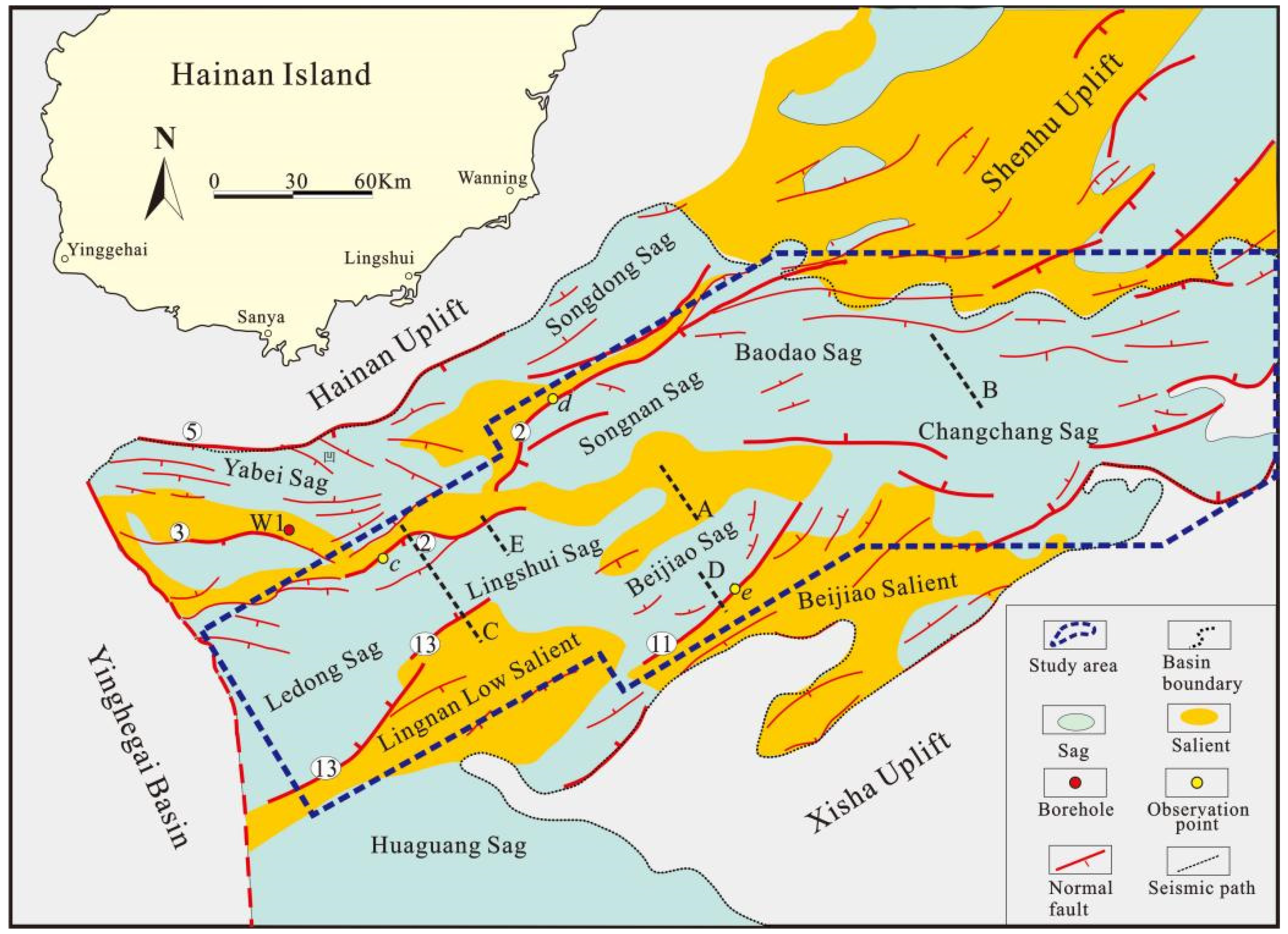
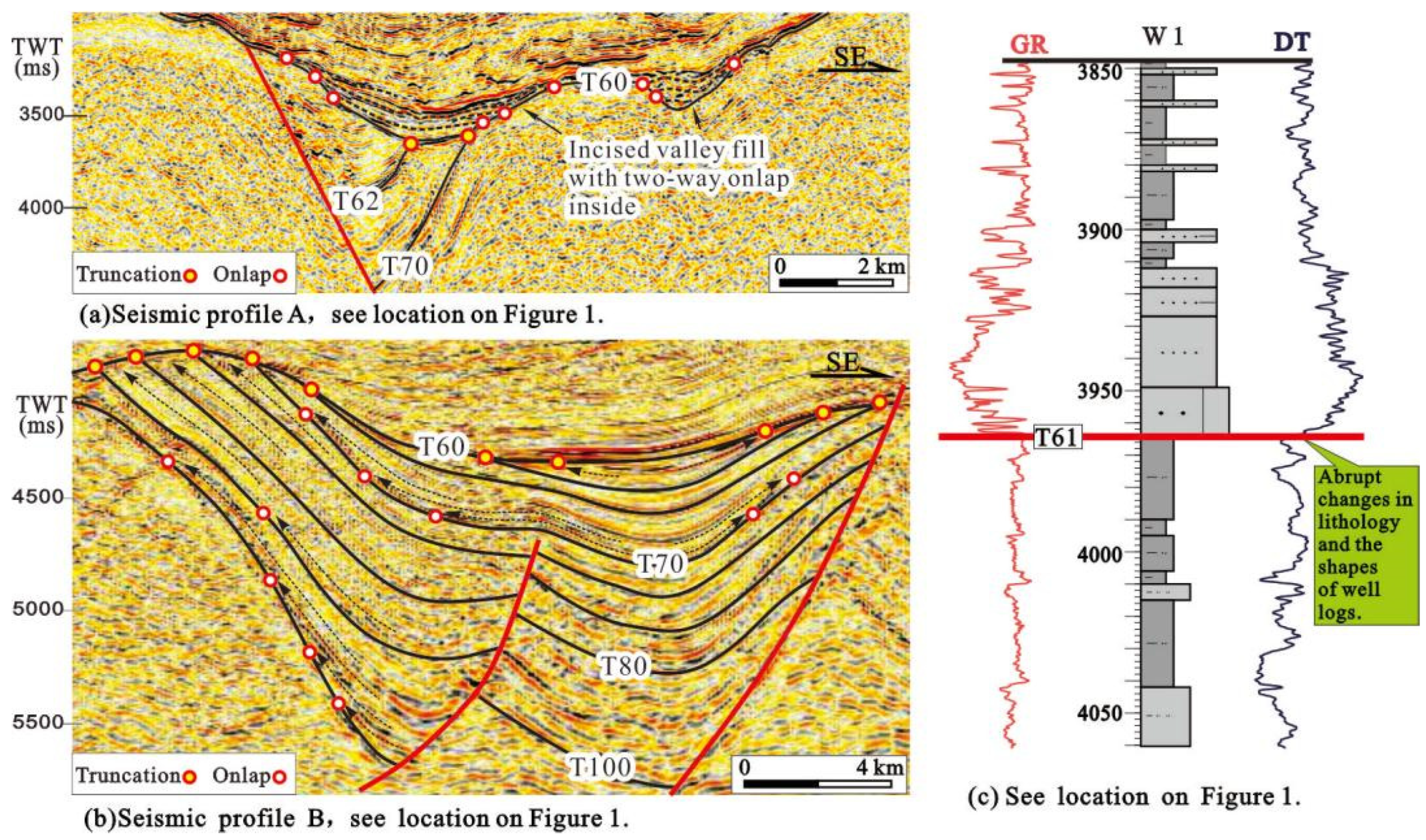
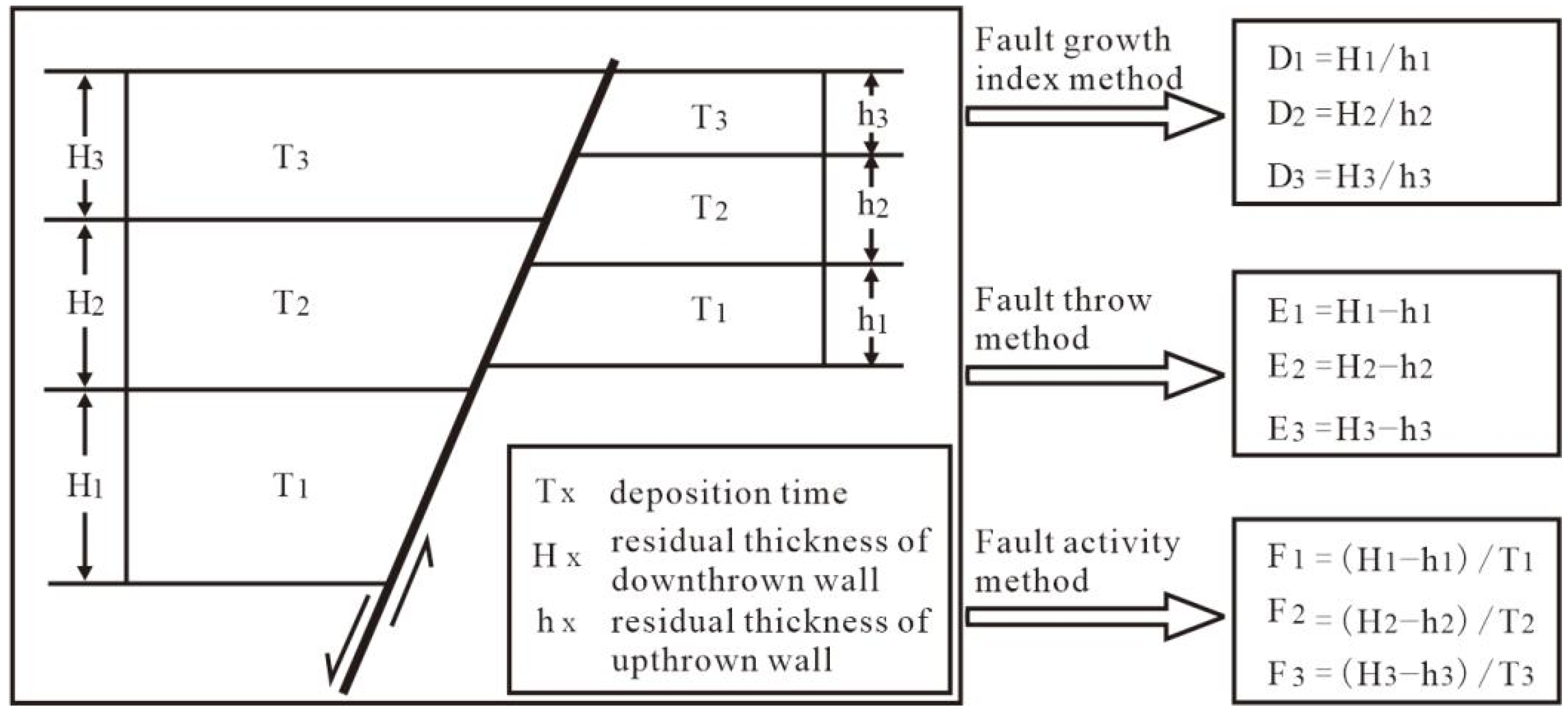

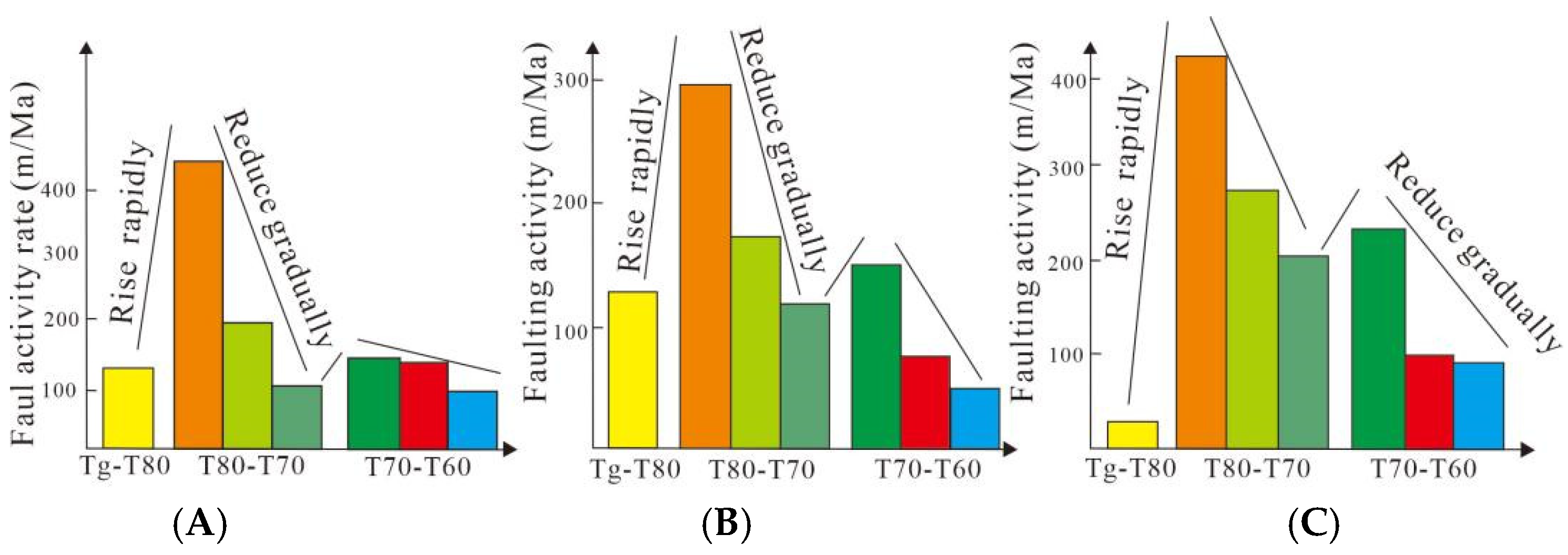
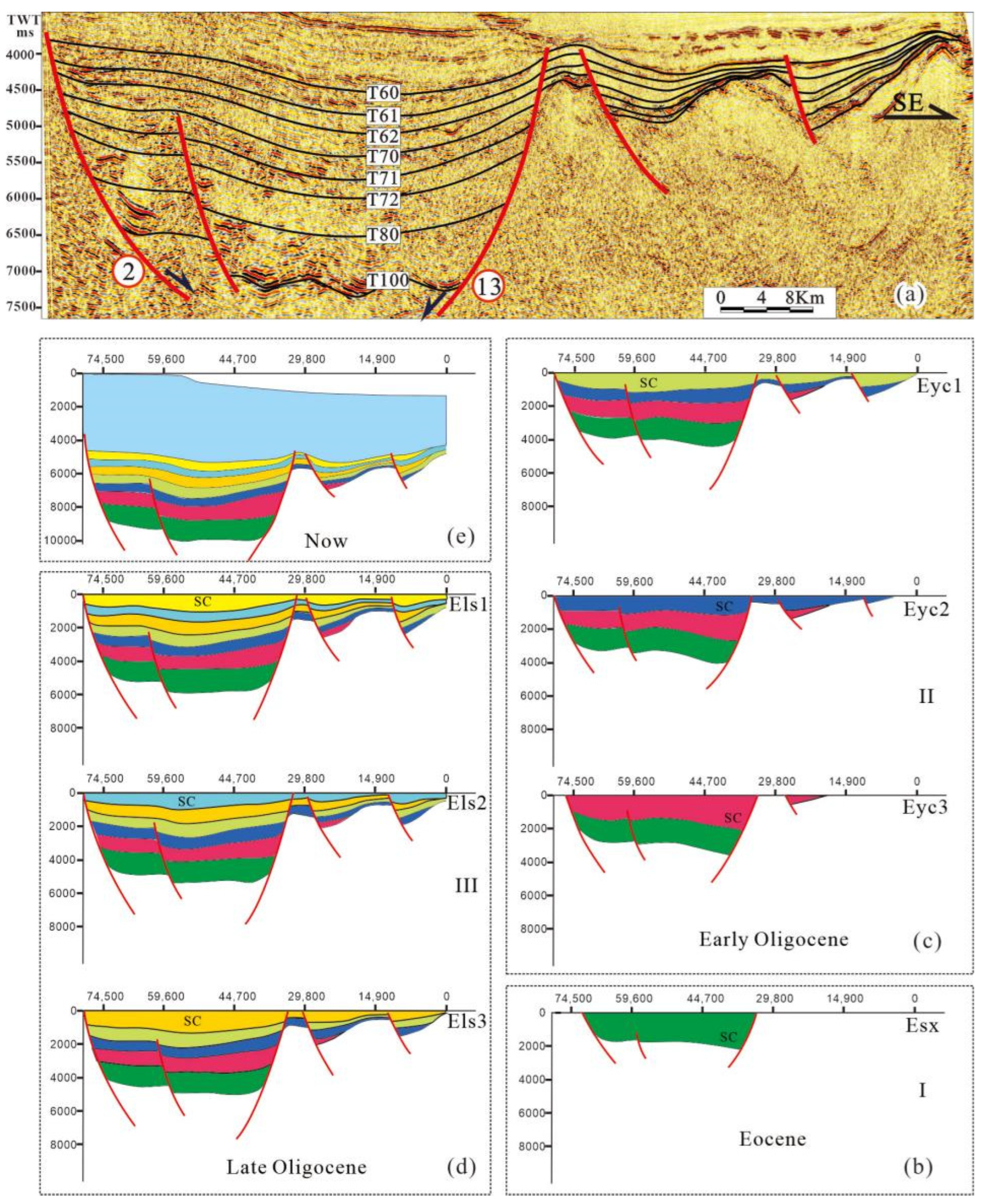
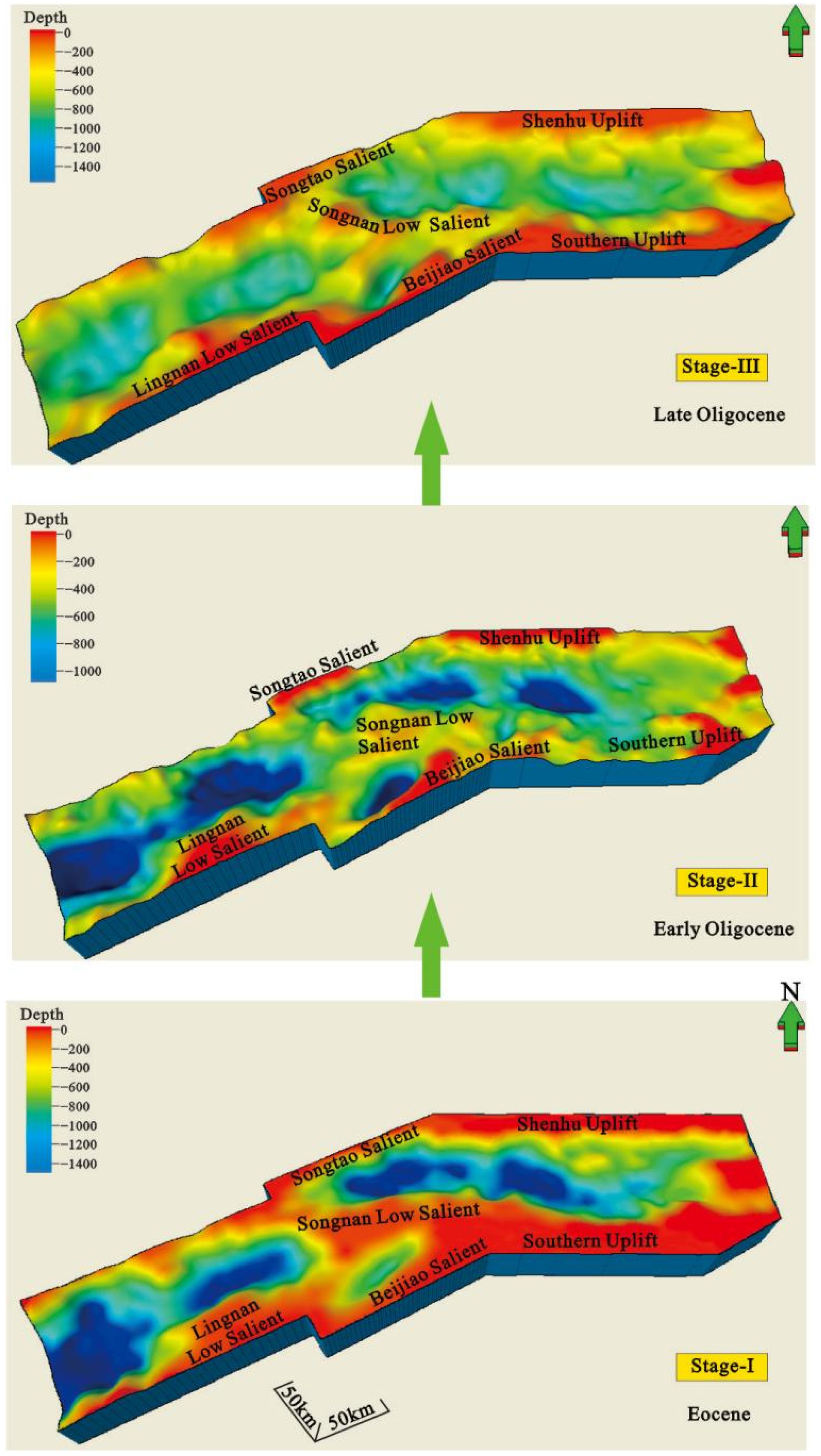

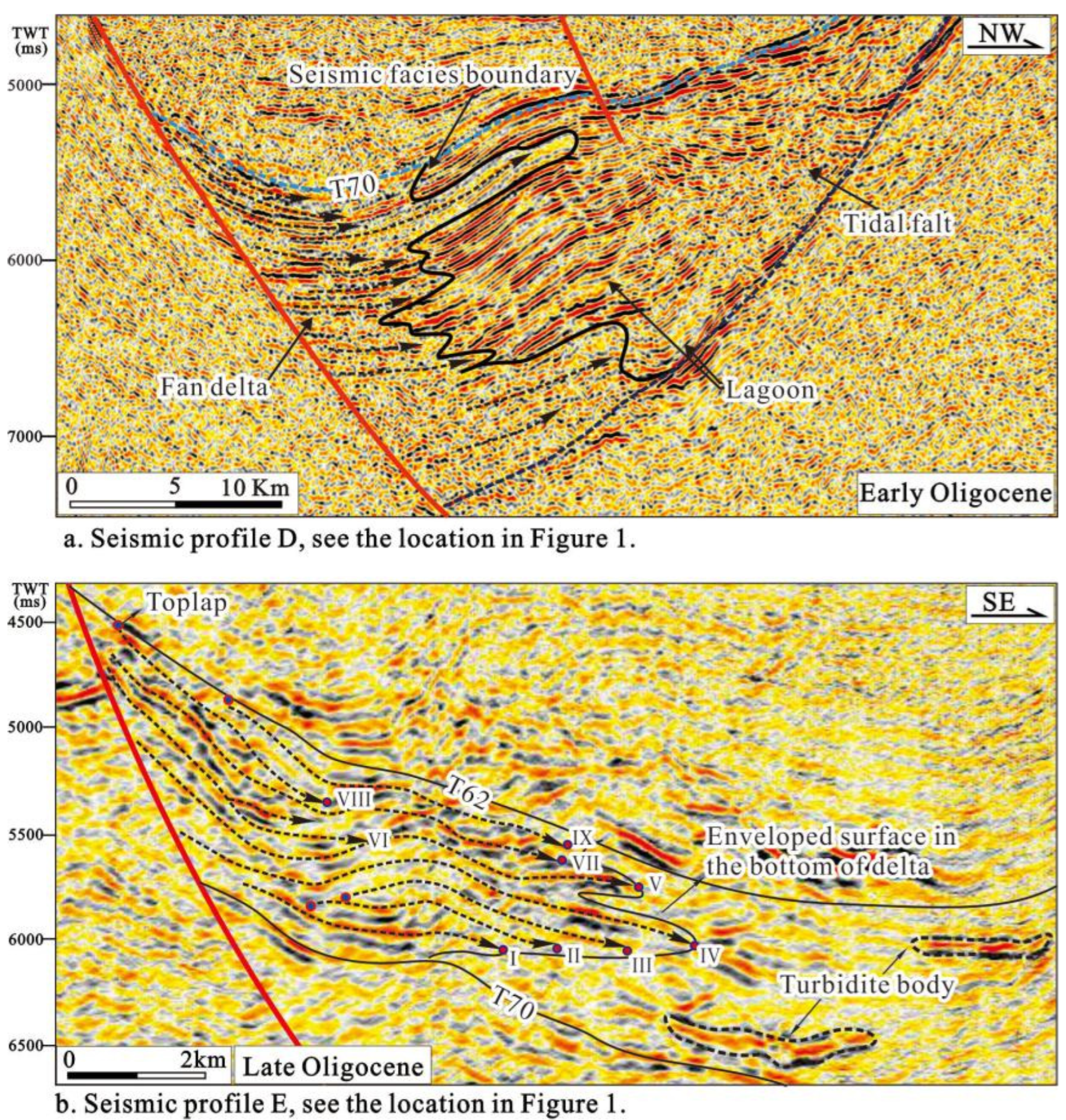
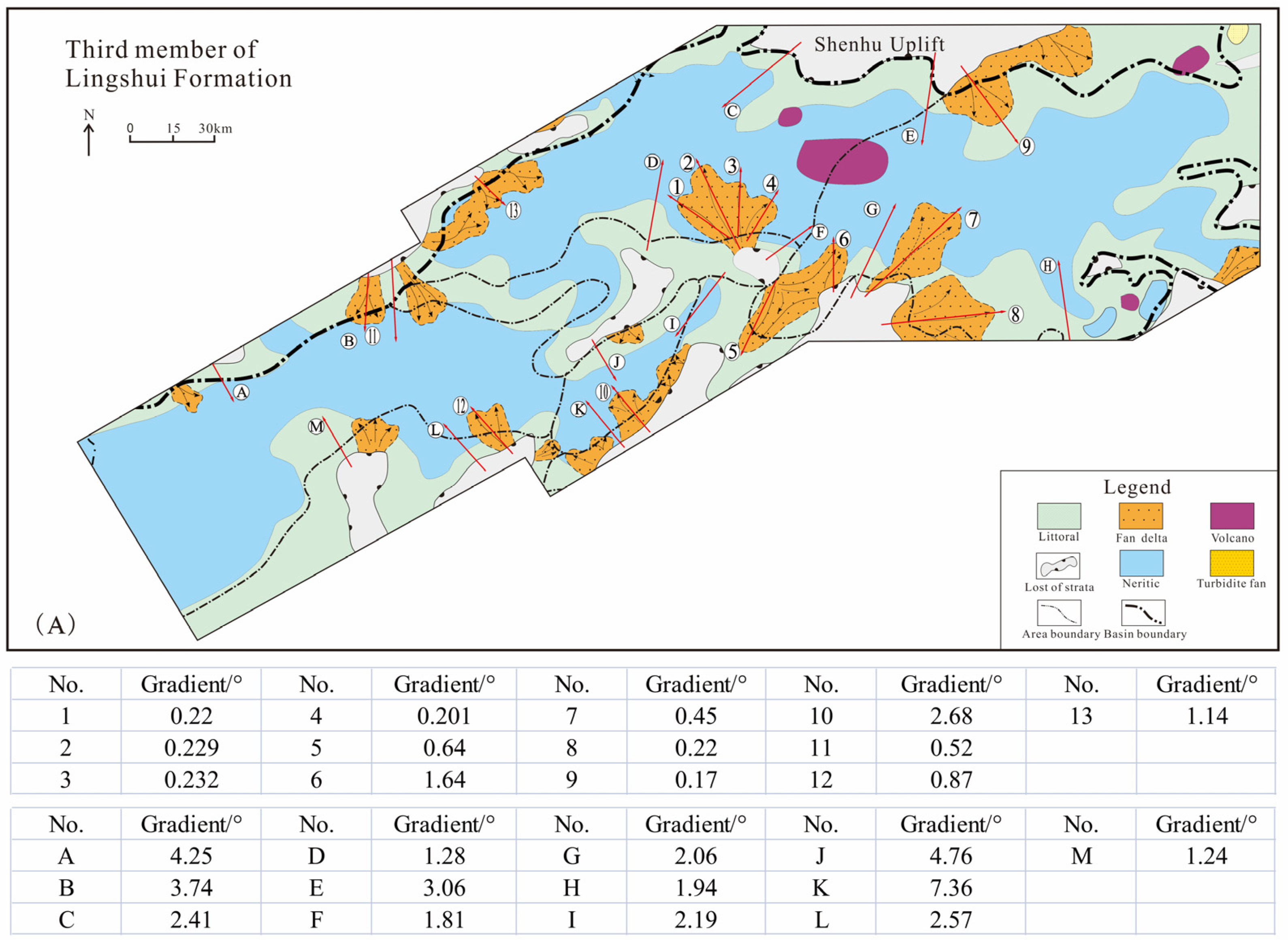
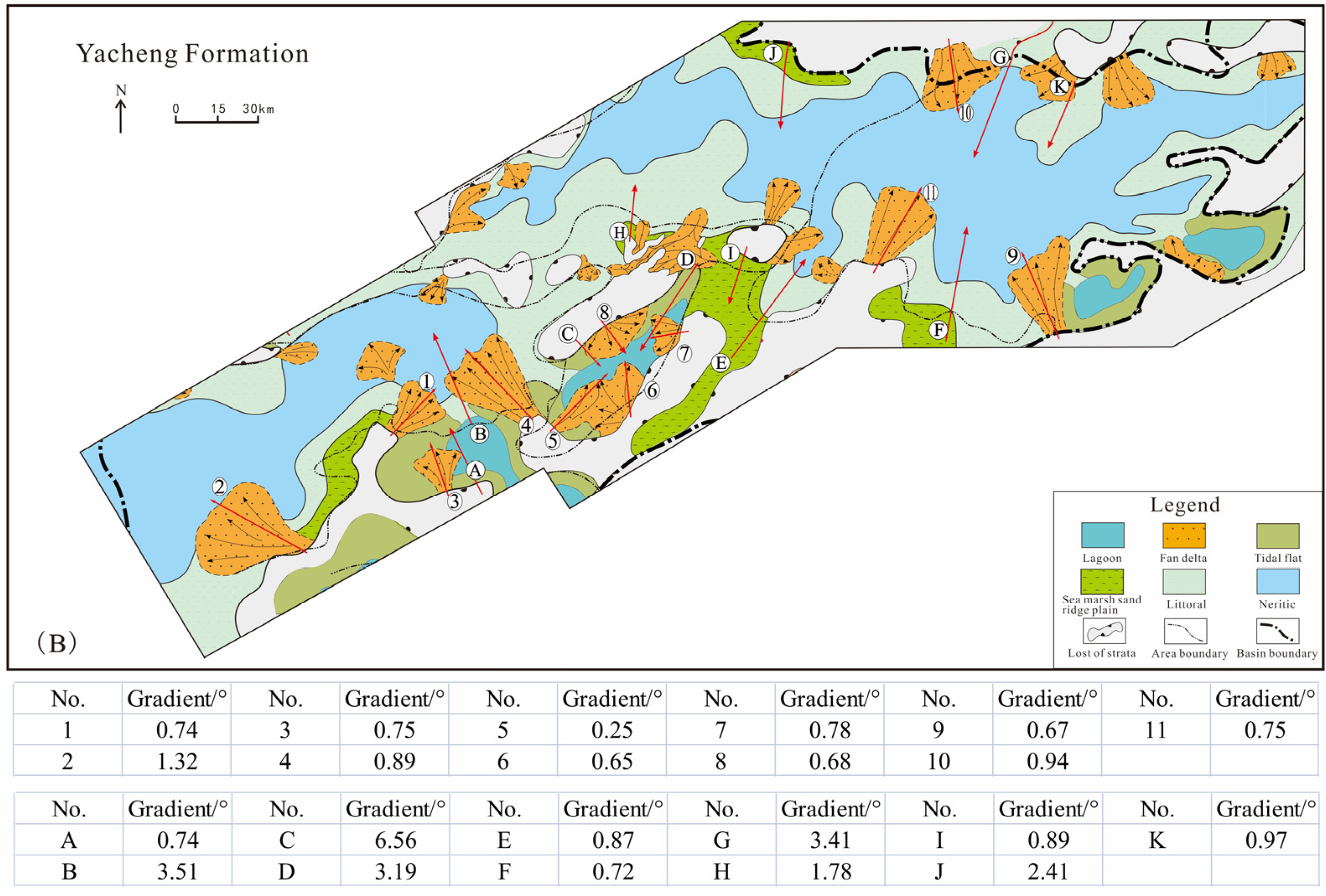
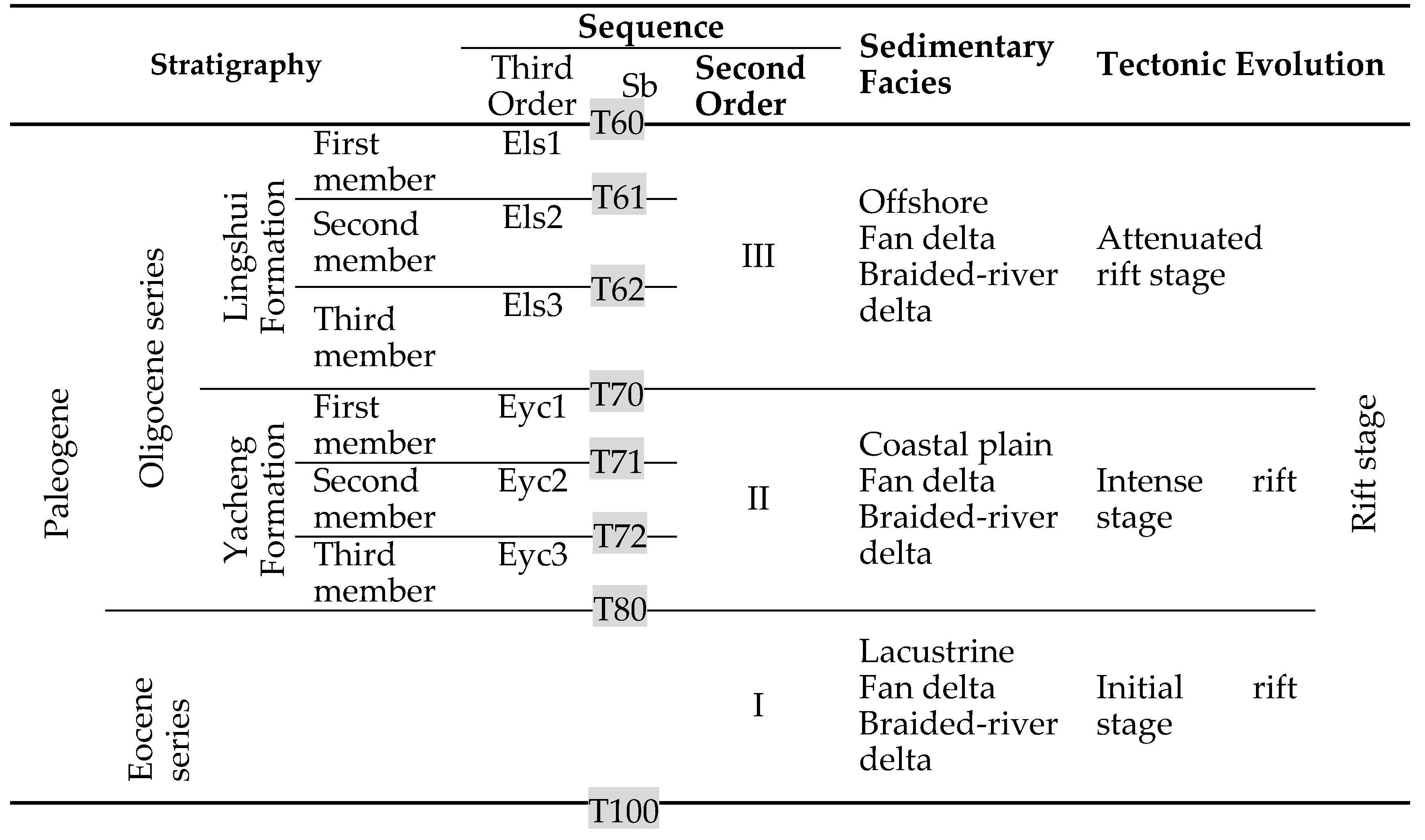

Disclaimer/Publisher’s Note: The statements, opinions and data contained in all publications are solely those of the individual author(s) and contributor(s) and not of MDPI and/or the editor(s). MDPI and/or the editor(s) disclaim responsibility for any injury to people or property resulting from any ideas, methods, instructions or products referred to in the content. |
© 2023 by the authors. Licensee MDPI, Basel, Switzerland. This article is an open access article distributed under the terms and conditions of the Creative Commons Attribution (CC BY) license (https://creativecommons.org/licenses/by/4.0/).
Share and Cite
Xu, M.; Song, G.; Li, Z.; Wang, D.; Sun, R.; Chen, Y. Periodic Characteristics of the Paleogene Tectonic Activity and Sedimentation Responses in the Deep-Water of Qiongdongnan Basin, South China Sea. Minerals 2023, 13, 262. https://doi.org/10.3390/min13020262
Xu M, Song G, Li Z, Wang D, Sun R, Chen Y. Periodic Characteristics of the Paleogene Tectonic Activity and Sedimentation Responses in the Deep-Water of Qiongdongnan Basin, South China Sea. Minerals. 2023; 13(2):262. https://doi.org/10.3390/min13020262
Chicago/Turabian StyleXu, Meng, Guangzeng Song, Zengxue Li, Dongdong Wang, Rui Sun, and Ying Chen. 2023. "Periodic Characteristics of the Paleogene Tectonic Activity and Sedimentation Responses in the Deep-Water of Qiongdongnan Basin, South China Sea" Minerals 13, no. 2: 262. https://doi.org/10.3390/min13020262
APA StyleXu, M., Song, G., Li, Z., Wang, D., Sun, R., & Chen, Y. (2023). Periodic Characteristics of the Paleogene Tectonic Activity and Sedimentation Responses in the Deep-Water of Qiongdongnan Basin, South China Sea. Minerals, 13(2), 262. https://doi.org/10.3390/min13020262





